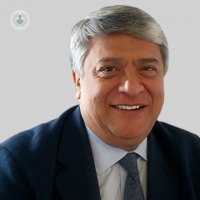Nervous system tumors
Written by:The Brain and Vertebral Neurosurgery Unit of the Ruber Hospital of Juan Bravo Street in Madrid, under the direction of Dr. Hugo Santos has been treating tumor pathology of the nervous system since 1987. In this Unit the advances of modern neurosurgery have been lived, applying the most avant-garde techniques, as much of diagnosis, as of treatment and rehabilitation in a single equipment, which allows an integral attention of the patient.
The central nervous system (brain and marrow) can be affected by both benign and malignant tumor processes.
The existence of cerebral pathology and one of its most frequent consequences, such as epilepsy, have obsessed humanity since antiquity. Trepanations found in skulls in pre-Columbian times in Mexico and other American lands, suggest that in some cases trepanates survived such surgery. It is in question even if in these cases the reason for effecting them was therapeutic or simply by magic or witchcraft.
In the diagnostic differentiation of brain and spinal tumor lesions, it is necessary to evaluate whether they are primitive tumors of the nervous system or lesions secondary to tumor processes in other parts of the organism (metastasis). It must also be taken into account if they are born from the cerebral parenchyma itself or if the origin is in structures that are closely related to them (nerve roots, meninges, arterial or venous vessels and bone). Much of the prognosis after the treatments instituted depends on this singularity. As in other types of tumors, there is predominance in age groups and sex. In tumors that are primitive of the cerebral or medullar parenchyma they emphasize those that are of extirpe glial, or commonly denominated astrocytomas, in its different degrees, among others.
Among the lesions that affect the nervous system but which have their origin in structures adjacent to it, such as meninges, meningiomas. Neurinomas are lesions that originate from nerve roots. There are lesions of vascular origin that can affect by mass effect or by bleeding, such as cavernous angiomas.
There are also tumor lesions that although not strictly cerebral can affect structures of the nervous system, as is the case of pituitary adenomas, when they affect the optic nerves.
The existence of tumoral processes should be suspected when there are alterations such as headache, dizziness, sensory or motor alterations or some other function such as hearing or neuralgia-like pains, such as the ones commonly called " posterior fossa '.
Clinical examination is the fundamental basis of the diagnosis to which it is necessary to add imaging tests to locate the situation of the lesion and thus have a diagnostic approach. We currently have advanced imaging systems, such as MRI, CT scan, cerebral digital arteriography. Electroencephalogram and combination of studies such as PET-CT are also extremely useful.
When it is time to indicate surgical treatment, in a unit like ours we have the appropriate equipment to carry out the surgical procedures. In this section it is necessary to mention especially the availability of equipment to carry out minimally invasive, microendoscopic surgeries complemented with the participation of neurophysiologists to monitor the cerebral functions even when the patient is anesthetized. In some cases, very specialized anesthetic techniques can be applied to carry out surgeries in an awake patient, without the latter having pain during the surgery.
Guided to estimate which is the best site to tackle an injury, is determined by both the navigational RM and intraoperative brain navigation equipment.
The patient, when deciding who will be the neurosurgical equipment that he / she attends to, must be sure that in addition to having all the technological advances, there is both an experienced neurosurgical team and adequate hospital facilities to carry to good end your treatment.
In the Ruber Hospital of Juan Bravo street we have the most advanced technology to resolve tumor processes, both at the brain and spinal cord. It has a very specialized diagnostic department for image. Operating theaters are the so-called "smart". The intensive care unit, like us, has extensive experience for the evaluation and postoperative treatment of the patient. In the plants, with nurses and experienced auxiliaries, we all formed a difficult team to match.




